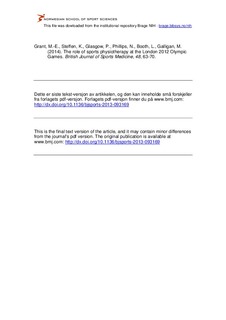| dc.contributor.author | Grant, Marie-Elaine | |
| dc.contributor.author | Steffen, Kathrin | |
| dc.contributor.author | Glasgow, Philip | |
| dc.contributor.author | Phillips, Nicola | |
| dc.contributor.author | Booth, Lynn | |
| dc.contributor.author | Galligan, Marie | |
| dc.date.accessioned | 2014-09-08T08:50:34Z | |
| dc.date.available | 2014-09-08T08:50:34Z | |
| dc.date.issued | 2013-11 | |
| dc.identifier.citation | British Journal of Sports Medicine. 2014, 48, 63-70 | nb_NO |
| dc.identifier.uri | http://hdl.handle.net/11250/218910 | |
| dc.description | I Brage finner du siste tekst-versjon av artikkelen, og den kan inneholde ubetydelige forskjeller fra forlagets pdf-versjon. Forlagets pdf-versjon finner du på bjsm.bmj.com: http://dx.doi.org/10.1136/bjsports-2013-093169 / In Brage you'll find the final text version of the article, and it may contain insignificant differences from the journal's pdf version. The definitive version is available at bjsm.bmj.com: http://dx.doi.org/10.1136/bjsports-2013-093169 | nb_NO |
| dc.description.abstract | Background: There is a lack of information on the utilisation of physiotherapy services at the Olympic Games.
Aim: To better understand the athlete and non-athlete requirements of the physiotherapy services at the Olympic Village Polyclinic during the London 2012 Olympic Games.
Methods: From 16 July to 14 August 2012, physiotherapy encounters for athletes and non-athletes (National Olympic Committee (NOC) team officials, coaches, team managers, workforce, Olympic family, technical officials and press) were recorded on the ATOS electronic medical records system at the polyclinic in the main Athletes’ Village in Stratford.
Results: Of the 1778 encounters, 1219 (69%) were administered to athletes and 559 (31%) to non-athletes. The anatomical areas most frequently recorded at the first visits for athletes were knee (15.4%), lumbar spine/lower back (15.2%) and upper leg (12.6%) and that for non-athletes were lumbar spine/lower back (19.8%), knee (15.8%) and neck/cervical spine. Muscle (33.3%) and joint injuries (24.8%) were the most common diagnoses in athletes and non-athletes (24.4% and 30.1%). The five most frequently used treatment modalities were therapeutic soft tissue techniques (23.3%), mobilisation techniques (21.8%), taping (8.9%), cryotherapy (6.9%) and exercise prescription (6.4%). The most common cause of athletes’ injuries was overuse (43.6%).
Conclusions: This study of the London 2012 Olympic Games workload highlights the physiotherapy needs of athletes as well as non-athletes and identifies the high numbers of pre-existing and overuse injuries in this setting, providing an insight into the reasons why the athletes seek physiotherapy support during the Olympic Games. | nb_NO |
| dc.language.iso | eng | nb_NO |
| dc.publisher | BMJ Publishing Group | nb_NO |
| dc.title | The role of sports physiotherapy at the London 2012 Olympic Games | nb_NO |
| dc.type | Journal article | nb_NO |
| dc.type | Peer reviewed | nb_NO |
| dc.subject.nsi | VDP::Social science: 200::Social science in sports: 330::Other subjects within physical education: 339 | nb_NO |
| dc.source.journal | British Journal of Sports Medicine | nb_NO |
| dc.description.localcode | Seksjon for idrettsmedisinske fag / Department of Sports Medicine | nb_NO |
